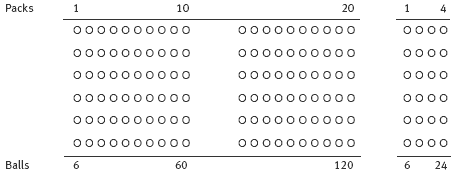This is a level 4 number activity from the Figure It Out series. It relates to Stage 7 of the Number Framework.
A PDF of the student activity is included.
Click on the image to enlarge it. Click again to close. Download PDF (779 KB)
use mental strategies for division problems
This activity models the use of different mental strategies in solving a division problem and then asks the students to apply these models to other questions. By doing this, the students will hopefully see that a division problem that cannot be solved in one step can be rearranged into a number of simpler steps based on the students’ knowledge of number relationships. It is not intended that the students will become skilful at using every one of these methods; rather, the different options should be seen as models of how it is often possible to reconstruct a difficult problem in a variety of ways.
A picture of the thinking used in Ashley’s method may take the form of an array where the 6-packs are lined up thus:
James’s method might be explained by modelling and recording simple versions of equivalent equations. Ask the students: “If 12 ÷ 6 = 2 and 6 ÷ 3 = 2, how are these equations the same and how are they different?” The answer 2 is the same, so 12 ÷ 6 is equivalent to 6 ÷ 3. That is, the results are the same, even though the factors are different.
Use cards, blocks, or beans to show how 12 shared out among 6 people gives the same result as sharing 6 out among 3 people.
Have the students explore a number of division equations that have the same answer until they see the equivalence involved.
Zoe’s method depends on knowing that 144 ÷ 6 is the same as 6 x = 144. It needs to be explained using the number properties that Zoe is thinking about. At this point, it could be helpful to explore the units digit in the six times table to see when it gives a result with 4 in the units column. This happens at 6 x 4 = 24 and at 6 x 9 = 54.
If the table is extended, it will be seen to occur next at 6 x 14 = 84, at 6 x 19 = 114, and then at 6 x 24 = 144 and 6 x 29 = 174. The key idea in Zoe’s method is that something ending in 4 must be added to 120 to get 144, and 6 x 4 = 24 is the one that fits.
The students could then be organised into three groups. Each group can be assigned a method for solving question 2a. After they have reported back on how to use Ashley’s, James’s, or Zoe’s method, assign them another method to try on question 2b. Continue this rotation for question 2c so that all the students have tried all three methods of thinking discussed on this page. You could then ask them to choose the method they think would be easiest for each of the remaining questions.
Answers to Activity
1. Display methods will vary.
2. Use of strategies will vary. The solutions are:
a. 31 packets
b. 19 weeks
c. 37 dozen (A dozen is 12.)
d. 24 CDs
e. 26 teams, with three players left over


